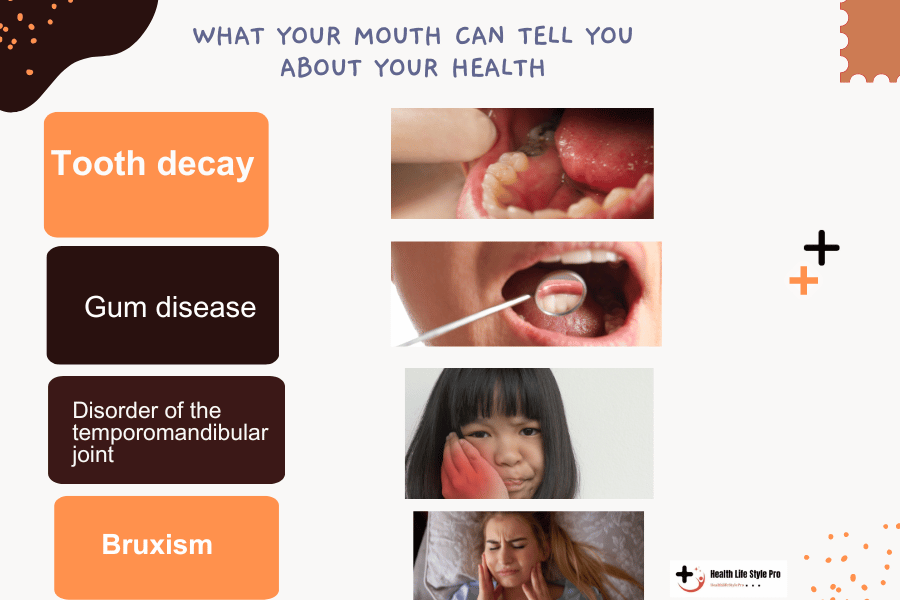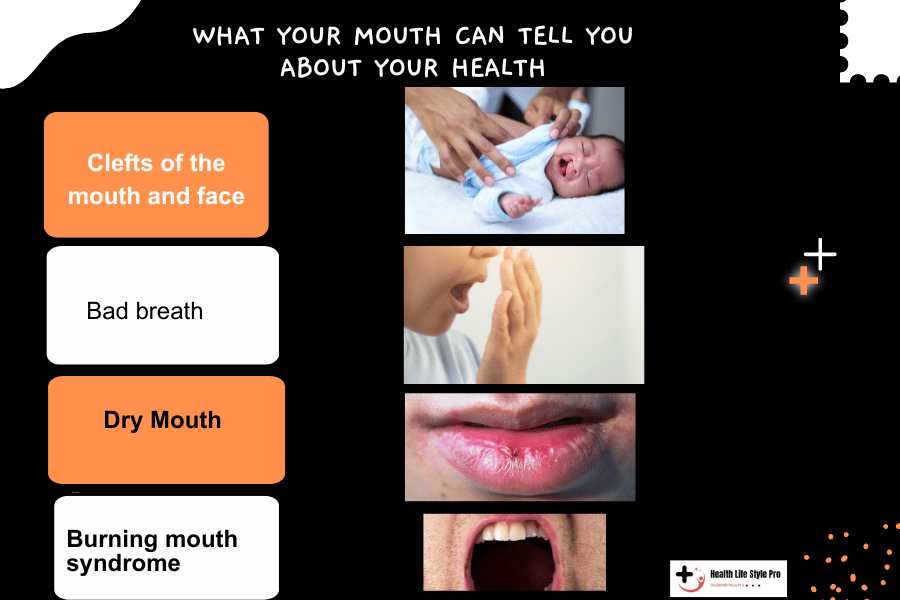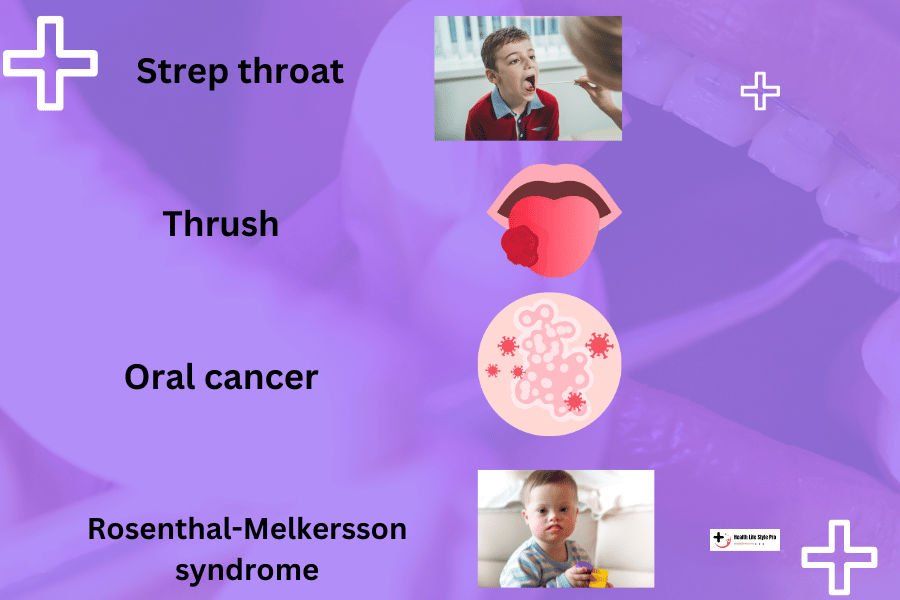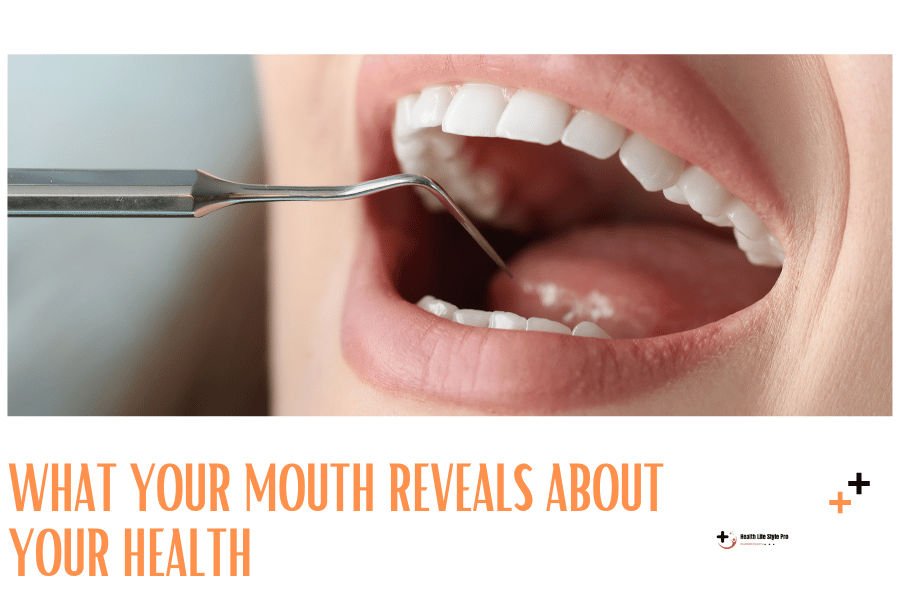The mouth is busy eating, drinking, breathing, smiling, frowning, and talking all day. It is prone to constant microbial attack as well as wear and tear from near-constant action. The mouth, as a doorway into the respiratory and digestive tracts, provides a glimpse into your general health. Here are a few of the numerous conditions that can affect the human mouth.
Tooth decay

Dental decay is frequent at all stages of life and has been related to a wide range of diseases, including cardiovascular disease, dementia, stomach ulcers, and renal failure. Bacteria in our mouths produce acids that erode the enamel surface of the tooth, creating caries (cavities). If cavities are left untreated, germs will target the softer dentin underlying the enamel, eventually infecting the tooth’s inner pulp. Symptoms include discolored teeth, hot and cold sensitivity, foul breath, and tooth or jaw pain.
Gum disease
Gum disease begins with gingivitis, which is a gum infection marked by swollen, red gums that bleed readily. The collection of germs (in the form of plaque) at the tooth’s base produces inflammation.
Disorder of the temporomandibular joint
Temporomandibular joint disease, or TMD, is a painful ailment that affects the jaw joint, which connects the lower jawbone to the skull and is involved in chewing, swallowing, speaking, and yawning. Jaw pain, trouble opening or closing the mouth, and a popping or clicking sound made when moving the jaw can all be signs of TMD.
Bruxism
Bruxism is the act of clenching or grinding one’s teeth when not eating. It is classified as a sleep-related movement condition since it typically occurs while sleeping, but it can also occur while awake. It is most prevalent in youngsters and has been linked to adult sleep apnea and stress. Poor sleep, migraines, neck and jaw pain, worn or broken teeth, and scalloped tongue indentations are all signs that you may be clenching or grinding your teeth.
Odontomas
Odontomas are benign tumors made up of dental tissue that might resemble an additional tooth or a group of tiny teeth. It’s the most frequent sort of dental tumor, and it usually appears in adolescence or early adulthood. Symptoms are frequently nonexistent, however they may include pain, swelling, and delayed eruption of permanent teeth. In a notable case in Chennai, India, doctors found 526 extra teeth in a tumor in a seven-year-old boy’s lower jaw.
Clefts of the mouth and face

The cleft palate and cleft lip are birth defects characterized by a split in the roof of the mouth and lip. Clefts can develop on one or both sides of the mouth, as well as in the lip or palate. This condition develops very early in pregnancy when the tissues or bony structures of the embryo’s lip and mouth fail to fuse properly as a result of genetic and environmental factors such as folic acid deficiency, smoking, diabetes, obesity, viral infections, and pregnancy-related medication use.
Bad breath
A 1920s Listerine marketing effort that touted an antiseptic rinse—then used for washing floors and treating gonorrhea—as a remedy for “chronic halitosis” pushed foul breath into the spotlight, generating years of social worries over bad breath. Halitosis is commonly caused by tonsil stones, dental decay, gum disease, and oral or sinus infections. Still, it can also indicate more serious illnesses such as diabetes, lung cancer, and cystic fibrosis.
Mouth Dryness
Dry mouth, also known as xerostomia, is a frequent disease that is not a disorder but a symptom or side effect.
It can be caused by drugs that restrict salivary flow, mouth breathing owing to nasal congestion, dehydration, salivary gland damage from cancer radiation therapy, and autoimmune disorders such as Sjögren’s syndrome, which attacks salivary cells Dry mouth impacts both quality of life and oral health by producing discomfort, changing taste, making speaking and swallowing harder, and increasing susceptibility to dental caries and fungal infections.
Syndrome of burning mouth
It is more common in postmenopausal women and is accompanied by dry mouth and taste alterations. The cause of the syndrome is unknown, but it could be due to nerve injury caused by hormonal fluctuations.
Oral hypersensitivity reactions
Oral hypersensitivity reactions are abnormal reactions in and around the mouth caused by even small amounts of normally safe substances such as meals, drugs, dental amalgams, and anesthetics. Symptoms can range from life-threatening allergic reactions like anaphylaxis to lesser symptoms such as swelling, stinging, burning, or ulcers in the mouth, as well as a type of gingivitis that turns the gums bright red. The reaction can be instantaneous or delayed, making it difficult to determine which chemical is to blame.
laryngitis

Laryngitis is a temporary or chronic inflammation of the larynx (also known as the voice box or glottis), an organ in the throat that houses the vocal cords and protects our airways from food waste, resulting in hoarseness, a sore throat, and/or cough. The most common cause of laryngitis is a respiratory infection, such as a cold or the flu; non-infectious reasons include vocal strain, acid reflux, allergies, cancer, autoimmune illness, polyps, smoking, and other inhaled irritants.
Tonsillitis
Tonsillitis is a tonsil infection that causes inflammation, painful throat, swollen neck glands, and fever. Tonsils are microscopic organs that are part of the lymph system; the most well-known are the palatine tonsils, which are located at the rear of each side of the throat. Tonsillitis is particularly common in youngsters, and some people have their tonsils removed if they have chronic tonsillitis.
Mouth ulcers
Mouth ulcers are tiny, superficial sores that develop on the tongue, inner cheeks, inner lips, or roof of the mouth. Aphthous ulcers, also known as canker sores, are the most common and usually go away on their own. However, mouth ulcers can be caused by a variety of conditions, including viral infections like COVID-19 and chikungunya, gastrointestinal diseases like celiac and Crohn’s, autoimmune disorders, and benign or malignant tumors.
Herpangina
It is most frequent among children under the age of ten, but it can happen to anyone.
Herpangina is an enterovirus infection caused by viruses that affect the gastrointestinal system. Infected feces frequently transmit it
Herpes simplex virus
The herpes simplex virus type 1 (HSV-1) is a highly infectious virus that usually infects nerve cells in the mouth and causes painful, fluid-filled blisters on and around the lips, sometimes known as cold sores or fever blisters. Infection lasts a lifetime, with more than two-thirds of persons globally contracting the virus by the age of 50. Carriers may not exhibit any symptoms at all, or they may occasionally develop blisters; tingling, heat, itching, or pain in the area where the blisters are about to form frequently precedes these episodes
Strep throat

The bacteria Streptococcus pyogenes, which also causes scarlet fever, is the cause of strep throat (pharyngitis), a dangerous tonsil and throat infection. The symptoms of strep throat, which are most common in children starting around age five, include fever, sore throat, especially when swallowing, swollen and red tonsils, and small red spots on the roof of the mouth. Younger children may also have nausea and vomiting. Failure to treat strep throat can lead to renal problems and rheumatic fever.
Thrush
Thrush, also known as oral candidiasis, is an overgrowth of Candida albicans, a yeast fungus prevalent in our gastrointestinal and skin flora that can occasionally multiply and cause significant infections.
Persons with healthy immune systems typically experience minimal oral infections, characterized by fuzzy white “cottage cheese” patches on the tongue, inner cheeks, roof of the mouth, and back of the throat.
Thrush is prevalent in babies, whose immune systems are still developing, and mothers can transmit it to their children while breastfeeding
Oral cancer
Oral cancer is the seventh most prevalent disease in men, affecting approximately 200,000 people globally each year, primarily older adults. The mouth can be affected, including the lips (where UV rays exposure is common), tongue, palate, cheeks, and gums. Non-healing sores or ulcers, white or red patches, loose teeth, bleeding, difficulty swallowing, and weight loss are all warning signs.
Macroglossia
Macroglossia is an uncommon disorder characterized by an excessively big tongue that can impair eating, breathing, speaking, and tooth and jaw growth. Ulcers near the tip of the tongue may form when it protrudes from the mouth. The condition can be congenital (alone or associated with other abnormalities such as Down syndrome) or acquired. Noncongenital causes include autoimmune and viral diseases, as well as metabolic abnormalities.
Rosenthal-Melkersson syndrome
Melkersson-Rosenthal syndrome is a rare neurological illness characterized by recurring swelling of the face and lips (typically the upper lip), a furrowed tongue, and facial paralysis. The swelling may become permanent with time. The illness is more common in women, and there is currently no cure. Its etiology is unknown, however genetics may be involved; it has also been connected to Crohn’s disease.
Common Questions:
How does your mouth affect your health?
The mouth plays a crucial role in various aspects of your well-being, and maintaining good oral health is essential:
- Gateway to your body: Your mouth is the entry point for food and drink, which are vital for nourishment. Poor oral health, like tooth decay or gum disease, can make eating uncomfortable or painful, potentially leading to nutritional deficiencies.
- Defense against infection: The mouth is teeming with bacteria, both beneficial and harmful. Maintaining good oral hygiene helps maintain a balance and prevents the overgrowth of harmful bacteria that can cause infections like cavities and gum disease.
- Connection to overall health: Research suggests a link between oral health and various health conditions, including heart disease, diabetes, and even respiratory problems. Poor oral health can increase inflammation in the body, potentially contributing to these conditions.
- Impact on self-esteem: A healthy mouth with strong teeth and fresh breath can boost self-confidence and social interaction. Conversely, oral health problems can lead to feelings of self-consciousness and affect your quality of life.
Therefore, practicing good oral hygiene by brushing twice daily, flossing regularly, and visiting the dentist for regular checkups is crucial for maintaining good health and well-being.
What are the signs of an unhealthy mouth?
Several signs can indicate an unhealthy mouth, and it’s important to be aware of them to seek proper dental care if needed. Here are some key signs:
- Bleeding gums: Healthy gums shouldn’t bleed when brushing or flossing. Bleeding is often a sign of inflammation, possibly due to gingivitis or gum disease.
- Chronic bad breath: While occasional bad breath is normal, persistent bad breath, also known as halitosis, can indicate poor oral hygiene, gum disease, or other underlying health issues.
- Toothache or pain: Pain in your teeth or gums can signal various problems, like tooth decay, gum disease, or even an abscessed tooth. Ignoring pain can lead to more serious complications.
- Swollen or receding gums: Healthy gums should be pink and firm, not swollen or receding. Swollen gums can be a sign of inflammation, while receding gums expose the tooth root, increasing sensitivity and risk of tooth loss.
- Loose teeth: Loose teeth can indicate gum disease, which weakens the bone supporting the teeth. This requires immediate dental attention to prevent tooth loss.
- Dry mouth: A constantly dry mouth can be uncomfortable and increase your risk of cavities. It can be caused by certain medications, dehydration, or underlying health conditions.
- Mouth sores: While some mouth sores are minor and heal on their own, persistent or recurring sores can signal underlying problems like vitamin deficiencies or even oral cancer.
- Tooth sensitivity: Increased sensitivity to hot, cold, or sweet foods and drinks can be a sign of worn enamel, receding gums, or even a cracked tooth.
Early diagnosis and intervention are key to maintaining good oral health and preventing potential complications.
How do you tell if you’re sick by looking in your mouth?
- While looking in your mouth won’t definitively tell you if you’re sick, some signs might indicate potential issues:
- Bleeding gums: This can be a sign of inflammation, possibly gum disease.
- White patches on the tongue or inner cheeks: This could be thrush (yeast infection) or another issue.
- Mouth sores: May suggest a vitamin deficiency or even oral cancer (less common).
- These signs can also occur due to other reasons unrelated to being sick.
- The absence of these signs doesn’t guarantee good health.
- Bottom line: It’s best to see a doctor or dentist for a proper diagnosis if you experience concerning symptoms.

I’m a seasoned content creator with 6+ years of experience crafting engaging, SEO-optimized content that drives traffic and rankings. I excel in keyword research, link building, and guest posting, ensuring your brand reaches new heights.

